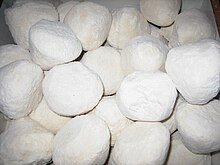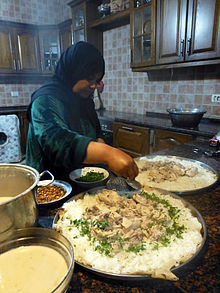Mansaf
Mansaf (Arabic: منسف [ˈmansaf]) is a traditional Jordanian dish made of lamb cooked in a sauce of fermented dried yogurt and served with rice or bulgur.
It is considered the national dish of Jordan, and can also be found in Kuwait, Saudi Arabia, Syria, and Palestine.
[4] The dish evolved greatly between the 1940s and late 1980s, undergoing changes in the recipe as well as in the preparation process.
Salt is added daily to thicken the yogurt even more for a few days, which then becomes very dense and is shaped into round balls.
The dish is served on a large platter with a layer of flatbread (markook or shrak) topped with rice and then meat, garnished with almonds and pine nuts, and then the creamy jameed sauce is poured on top of the dish.
[9] Mansaf is associated with a traditional Jordanian culture based on an agro-pastoral lifestyle in which meat and yogurt are readily available.
[10] Mansaf plays an active role in settling tribal disputes in Jordan in what is known as an Atwa (truce) and a Ja'ha (peacemaking process).
Massad notes that the current form of mansaf differs from the independence-era and Mandate-era recipes but is portrayed by the state as a dish that is both national and a Bedouin tradition,[6] despite it also historically being a dish of the peasants and Bedouins of the neighboring regions of southern Palestine and Syria.
[18][19] Prior to 1945, mansaf was made up of three main components: the bread, the meat and the clarified butter.
The final step was pouring the clarified butter, called samin beladee, on top.
[22] Around the 1950s, replacing bulgur wheat with rice started to rise in popularity when making mansaf, due to the proximity of a city in Jordan called Hartha to Syrian and Palestinian borders.
[24] Prior to the 1970s, mansaf was cooked in a large copper cauldron that was placed over a fire in the courtyards of one's home.



